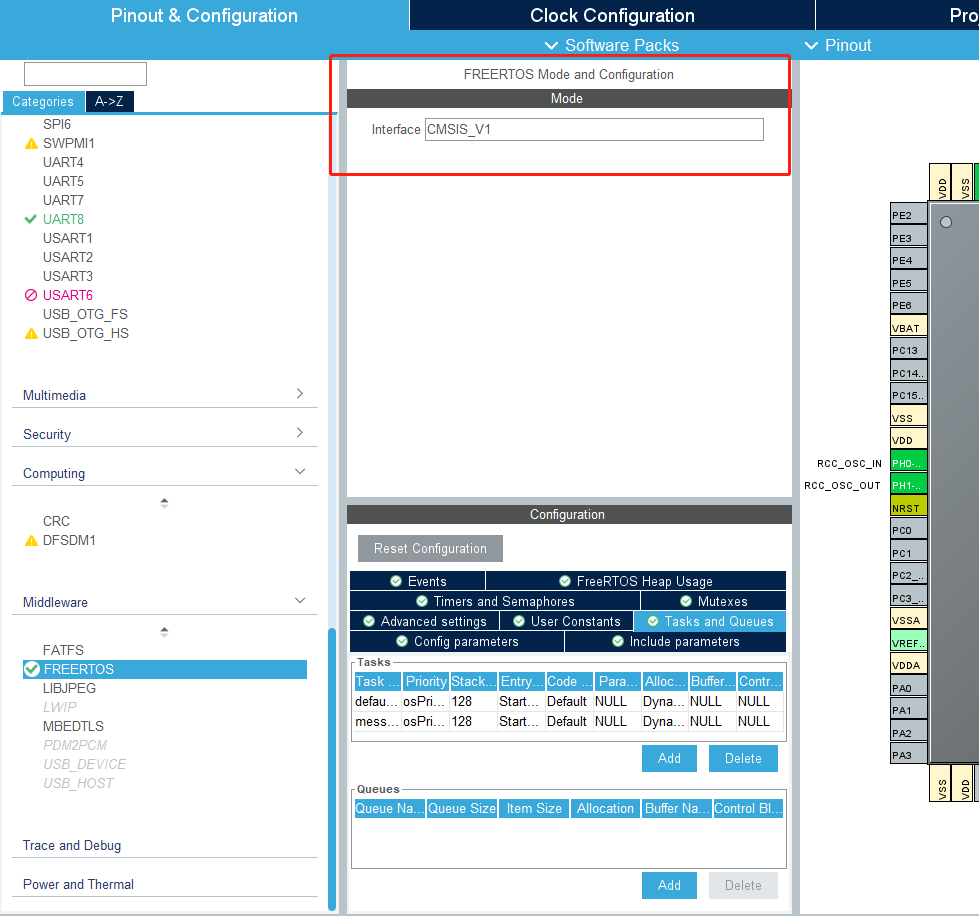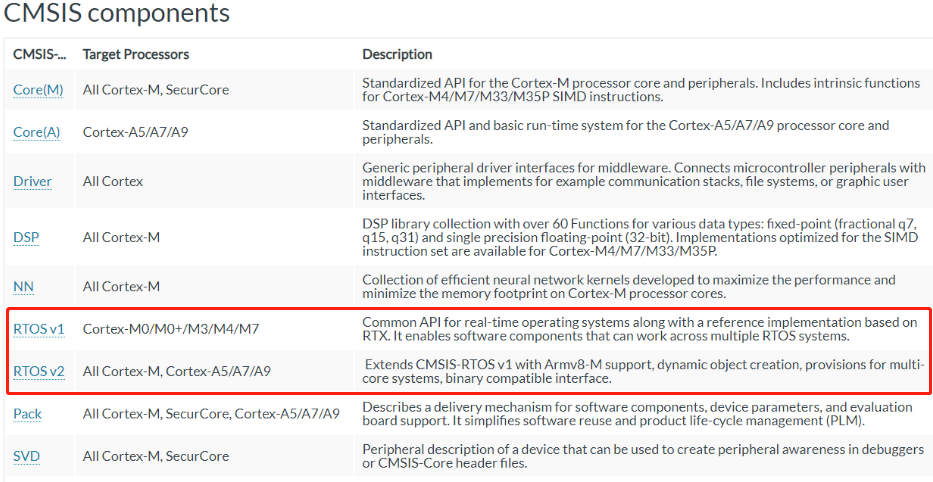STM32CubeIDE在stm32開發者起著最基礎的作用,在STM32CubeIDE中配置FreeRTOS中間層時需要選擇interface,其中有三個選項:Disable、CMSIS_V1和CMSIS_V2
CMSIS定義了通用工具接口,并提供一致的設備支持,那么CMSIS_V1和CMSIS_V2有什么區別呢,該怎選擇呢?

微控制器軟件接口標準CMSIS
CMSIS ARM官方定義如下:

Cortex微控制器軟件接口標準(CMSIS)是獨立于供應商的硬件抽象層,用于基于Arm Cortex處理器的微控制器,并且CMSIS提供了到處理器和外圍設備,實時操作系統以及中間件組件的接口,可以說非常實用。
CMSIS軟件接口簡化了軟件重用,減少了開發周期,而且也不受限操作系統的類型,去耦。
不同之處
RTOS v1創建任務函數如下:
/***********************ThreadManagement*****************************/
/**
*@briefCreateathreadandaddittoActiveThreadsandsetittostateREADY.
*@paramthread_defthreaddefinitionreferencedwith
efosThread.
*@paramargumentpointerthatispassedtothethreadfunctionasstartargument.
*@retvalthreadIDforreferencebyotherfunctionsorNULLincaseoferror.
*@noteMUSTREMAINUNCHANGED:osThreadCreateshallbeconsistentineveryCMSIS-RTOS.
*/
osThreadIdosThreadCreate(constosThreadDef_t*thread_def,void*argument)
{
TaskHandle_thandle;
#if(configSUPPORT_STATIC_ALLOCATION==1)&&(configSUPPORT_DYNAMIC_ALLOCATION==1)
if((thread_def->buffer!=NULL)&&(thread_def->controlblock!=NULL)){
handle=xTaskCreateStatic((TaskFunction_t)thread_def->pthread,(constportCHAR*)thread_def->name,
thread_def->stacksize,argument,makeFreeRtosPriority(thread_def->tpriority),
thread_def->buffer,thread_def->controlblock);
}
else{
if(xTaskCreate((TaskFunction_t)thread_def->pthread,(constportCHAR*)thread_def->name,
thread_def->stacksize,argument,makeFreeRtosPriority(thread_def->tpriority),
&handle)!=pdPASS){
returnNULL;
}
}
#elif(configSUPPORT_STATIC_ALLOCATION==1)
handle=xTaskCreateStatic((TaskFunction_t)thread_def->pthread,(constportCHAR*)thread_def->name,
thread_def->stacksize,argument,makeFreeRtosPriority(thread_def->tpriority),
thread_def->buffer,thread_def->controlblock);
#else
if(xTaskCreate((TaskFunction_t)thread_def->pthread,(constportCHAR*)thread_def->name,
thread_def->stacksize,argument,makeFreeRtosPriority(thread_def->tpriority),
&handle)!=pdPASS){
returnNULL;
}
#endif
returnhandle;
}
RTOS v2創建任務函數如下:
osThreadId_tosThreadNew(osThreadFunc_tfunc,void*argument,constosThreadAttr_t*attr){
constchar*name;
uint32_tstack;
TaskHandle_thTask;
UBaseType_tprio;
int32_tmem;
hTask=NULL;
if(!IS_IRQ()&&(func!=NULL)){
stack=configMINIMAL_STACK_SIZE;
prio=(UBaseType_t)osPriorityNormal;
name=NULL;
mem=-1;
if(attr!=NULL){
if(attr->name!=NULL){
name=attr->name;
}
if(attr->priority!=osPriorityNone){
prio=(UBaseType_t)attr->priority;
}
if((prioosPriorityISR)||((attr->attr_bits&osThreadJoinable)==osThreadJoinable)){
return(NULL);
}
if(attr->stack_size>0U){
/*InFreeRTOSstackisnotinbytes,butinsizeof(StackType_t)whichis4onARMports.*/
/*Stacksizeshouldbetherefore4bytealignedinordertoavoiddivisioncausedsideeffects*/
stack=attr->stack_size/sizeof(StackType_t);
}
if((attr->cb_mem!=NULL)&&(attr->cb_size>=sizeof(StaticTask_t))&&
(attr->stack_mem!=NULL)&&(attr->stack_size>0U)){
mem=1;
}
else{
if((attr->cb_mem==NULL)&&(attr->cb_size==0U)&&(attr->stack_mem==NULL)){
mem=0;
}
}
}
else{
mem=0;
}
if(mem==1){
#if(configSUPPORT_STATIC_ALLOCATION==1)
hTask=xTaskCreateStatic((TaskFunction_t)func,name,stack,argument,prio,(StackType_t*)attr->stack_mem,
(StaticTask_t*)attr->cb_mem);
#endif
}
else{
if(mem==0){
#if(configSUPPORT_DYNAMIC_ALLOCATION==1)
if(xTaskCreate((TaskFunction_t)func,name,(uint16_t)stack,argument,prio,&hTask)!=pdPASS){
hTask=NULL;
}
#endif
}
}
}
return((osThreadId_t)hTask);
}
正常V1夠用了,普通功能選V1,高級功能選擇V2:
我分別選擇CMSIS_V1和CMSIS_V2編譯了兩次進行對比,CMSIS_V2都要大一些。
審核編輯 :李倩
-
微控制器
+關注
關注
48文章
7953瀏覽量
155046 -
cpu
+關注
關注
68文章
11080瀏覽量
217084 -
CMSIS
+關注
關注
0文章
41瀏覽量
12327
原文標題:stm32CubeIDE中CMSIS_V1和CMSIS_V2選項的區別
文章出處:【微信號:技術讓夢想更偉大,微信公眾號:技術讓夢想更偉大】歡迎添加關注!文章轉載請注明出處。
發布評論請先 登錄
CubeMX創建STM32F1 FreeRTOS選擇新版庫1.8.6后工程出錯是怎么回事?
ATX主板和ITX主板有什么區別?
AIGC和AI有什么區別
BNC連接器對于工業方面該如何選擇呢?

想選一個10或12bit的ADC,有哪些ADC可以選擇呢?SPS該如何計算呢?
ADS1255 MUX寄存器設置上,AINP與AINN該如何選擇呢?
MAX44290ANT+T和MAX44290ANT+TG7有什么區別呢?
請問PurePath里面帶ROM和不帶ROM的元件有什么區別呢?
LM211的OC門輸出和COL輸出有什么區別嗎?
域名、IP 地址、網址分別是什么?有什么區別呢?






 CMSIS_V1和CMSIS_V2有什么區別呢,該怎選擇呢?
CMSIS_V1和CMSIS_V2有什么區別呢,該怎選擇呢?











評論